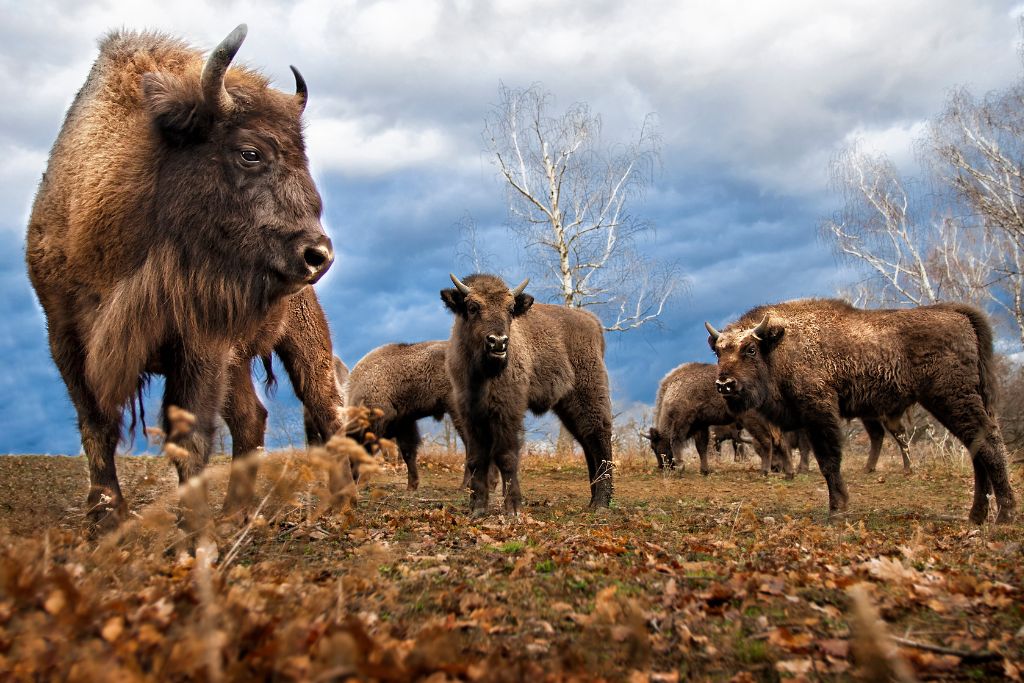In September 2022, wildlife rangers working at the Wilder Blean bison project near Canterbury in Kent, discovered a bison calf, the first born wild in the United Kingdom in thousands of years. Despite being totally extinct in the wild in the UK and Europe since the 20th century mainly because of habitat destruction and hunting, bison were able to cling on to survival through small captive herds in zoos. In recent years, they have been bred and released with quite some success in Poland, Belarus, Denmark, Russia, and further afield. Wild European bison populations are now thought to number over 9,000. Yet, their return to British shores has been much more recent and on a far smaller scale.
—
In July 2022, three female bison were released into woodlands near Canterbury in Kent in order to return the forest to a more natural and diverse habitat. It was subsequently discovered that one of the females introduced was already pregnant. As Tom Gibbs, one of the specialist bison rangers, remarked, bison “naturally conceal being in calf to avoid being hunted as a survival mechanism.”
The birth of this calf marks a major moment for nature restoration in Britain, though it is not without controversy. Some critics cite the fact that they went extinct in the UK during the last ice age as evidence that they would not be suited to the contemporary British climate. Nevertheless, the appetite for restoration and reintroduction has been growing steadily in the UK and all across Europe in recent years. Part of the argument advanced by rewilding advocates is that the bison would serve as a proxy for another extinct megafauna such as the auroch.
You might also like: Should We Clone Endangered Species?
Bison: Engineers of the Ecosystem
The importance of megafauna cannot be overstated from an environmental viewpoint. The loss of the bison and its close relative, the auroch, helped to precipitate the rapid decline in European biodiversity because of their disproportionately large influence on their natural environment relative to their numbers.
Species such as these are known as ‘keystone species’ and can be seen as ecosystem engineers as they “have been shown to respond to, and create, habitat heterogeneity”. In practice, this means that they help boost diversity by creating ecological niches for other species whether flora or fauna. In the case of bison, this is achieved by creating pathways through dense forest, thereby facilitating the movement of other species and preventing encroachment of colonising plants. Their “heavyweight grazing” is also significant in this regard as it suppresses some areas of vegetation and creates a semi-open woodland-pasture habitat.
Considering that the encroachment of woody plants into grasslands and savannahs has “increased dramatically” over the last century, thereby reducing range quality for livestock in North American grasslands, shrublands and savannahs, bison have an important role to play in the reversal of this trend.
The disturbance of the soil after bison have grazed an area also allows for a variety of pioneer plant species to develop. Moreover, activities like mud wallowing open up water holes, further developing the ecological complexity of the ecosystem and generating a wider variety of micro habitats. This process has a direct benefit in helping to hold water on the landscape for longer periods of time, reducing risks from flooding and erosion, while providing a source of drinking water away from streams and ponds. More than this, water holes provide a breeding and hunting ground for amphibians and insects which have born much of the brunt of biomass decline.
In terms of relation to other species, smaller herbivores like deer can find protection in the bison herd, in much the same way that antelope like impala associate with herds of large grazers like wildebeest and buffalo. The distinct grazing preferences of many herbivores also serves to facilitate the feeding and breeding of others. For instance, bison graze grasses at different heights, generating breeding grounds for ground-nesting bird species, as well as providing a food source by flushing insects from grasslands for waiting birds. Moreover, birds like the Long-Billed Curlew camouflage their nests in patterns that mimic bison droppings, and line their nests with bison fur. Bison provide sustenance to many bird species in the form of ectoparasites like ticks and through the undigested organic matter in their dung.
We can compare this to the relationship between the grazing species of the African bush, such as wildebeest, and birds like Red-Billed Oxpeckers or Western Cattle Egrets. The former picks ticks from the skin of grazing mammals, feeding itself while cleaning the host. Cattle Egrets meanwhile, follow the herds, consuming the insects disturbed from the grass.
You might also like: The Remarkable Benefits of Biodiversity
Bring Back the Bison
There is no doubt that European habitats are less biodiverse and thus more vulnerable as a direct result of the lack of megafauna present. Indeed, as the Encyclopaedia of Biodiversity states, “the loss of a keystone species will produce a cascade of effects on the diversity and function of the remainder of the ecosystem”.
One of the simplest tools we have at our disposal to reverse the devastating decline of global biodiversity is to reintroduce large mammals to our landscapes, mammals that naturally should be present in large numbers. As the experiment in a small woodland in Kent has shown, we may be surprised by the speed of the results.

















